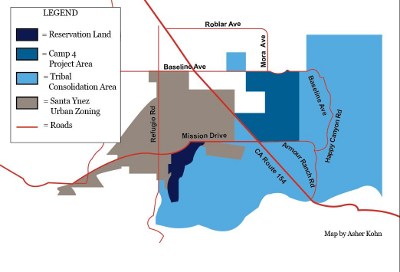The newly incorporated City of Goleta had the authority to reject a final subdivision map after the Santa Barbara County Board of Supervisors had approved the tentative map for property that was in unincorporated territory at the time, the state Supreme Court has ruled.
In a relatively short opinion, the state’s high court found that the Subdivision Map Act supported the city’s decision, and that the developer’s reliance on the county’s map approval did not prohibit the city from exercising its authority. Justice Carol Corrigan wrote the opinion, which was joined by five other justices. Only Justice Joyce Kennard dissented.
The case attracted a great deal of attention. The League of California Cities and the Sierra Club were among the organizations filing briefs supporting the city, while the California Association of Realtors, the Pacific Legal Foundation, the Building Industry Association and the state Department of Housing and Community Development were among the developer’s legal supporters.
The ruling would appear to address a rare situation. However, the California Association of Local Agency Formation Commissions reports that as many as 23 communities are considering incorporation.
In 1999, Oly Chadmar Sandpiper General Partnership submitted an application for a 109-unit condominium project on 14.5 acres in Goleta. At the time, the community a few miles west of Santa Barbara was unincorporated. In October 2001, the Santa Barbara County Planning Commission approved a vesting tentative map for the project. Six days later, Goleta citizens voted for incorporation. Two community groups appealed approval of the Sandpiper project to the Board of Supervisors, which then approved the project on January 15, 2002, even though newly elected Goleta councilmembers had made known their opposition. Goleta legally became a city on February 1, 2002.
When Sandpiper came before the City Council a few months later for final map approval — usually a ministerial action based on the developer meeting the conditions of the tentative map — the City Council refused to provide approval. Sandpiper sued, and Santa Barbara County Superior Court Judge J. William McLafferty ruled for the developer. On appeal, the Second District Court of Appeal overruled the lower court and held that Goleta had authority to deny the final map.
The state Supreme Court then took the case and a 6-1 majority voted to uphold the appellate court.
First off, the court said that the “vesting” nature of Sandpiper’s tentative map was not a factor. At issue was Government Code § 66413.5, a portion of the Subdivision Map Act. This section, approved in 1998, provides that a newly incorporated city must approve a final map when a tentative map has been approved by the county and meets all conditions of the final map. However, the law has an exception for an instance when a tentative map is submitted after the first signature is placed on an incorporation petition. Citing a bill analysis, Justice Corrigan wrote that this exception was intended to prevent a “run on development rights” when incorporation appeared imminent.
In this case, Sandpiper submitted its project application after incorporation petitions were first signed. Still, the developer agued that ministerial approval was required because the city, upon incorporation, adopted the county’s ordinances, which compelled ministerial approval. The City argued that the City Council was the final decision-maker for all tentative maps, and that the city was obligated to approve final maps only when the city approved the tentative map.
With little analysis, the court sided with the city. “We conclude the city had discretion under § 66413.5 to disapprove the final map because it had not approved the tentative map,” the court ruled.
Sandpiper also argued that the city was estopped — or precluded — from rejecting the final map because Sandpiper had invested $90,000 to move the project forward in reliance on the county’s approval of the tentative map. The developer said it was unaware the city opposed the project, and noted that the city excluded the project from a building moratorium.
But the court said Sandpiper had not established the elements of estoppel because the developer did not have reason to rely on the city’s support. “City authorities began voicing concerns about the project from virtually the moment of the city’s creation,” Corrigan wrote. “The City Council continued to identify problems with Sandpiper’s plan at its meetings in August through November of 2002. In light of this history, the city’s decision to disapprove the final map should not have come as a surprise to Sandpiper.” In addition, the court noted, the city exempted the project from the moratorium because state law (Government Code § 65858(c)(1)) required the exemption for a multi-family housing project.
In a dissenting opinion, Justice Kennard wrote that § 66413.5 was “irrelevant here” because the tentative map fell into the statutory exception. Instead, § 66474.1 should apply, and that section does not give the city discretion to reject the map, she wrote.
“When Goleta denied approval of Sandpiper’s final, conforming subdivision map on January 6, 2003, some 11 months after Goleta’s incorporation took effect, it had not enacted subdivision ordinances of its own, as it could have, either to supercede those it took over from the county or to supplement the state law procedural requirements imposed by the map act,” Kennard wrote.
The Case:
City of Goleta v. Superior Court, No. S129125, 06 C.D.O.S. 11729, 2006 DJDAR 16559. Filed December 21, 2006.
The Lawyers:
For Goleta: Amy Morgan, Burke, Williams & Sorensen, (951) 788-0100.
For Oly Chadmar Sandpiper: Patrick Breen, Allen, Matkins, Leck, Gamble & Mallory, (213) 622-5555.


